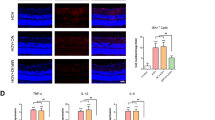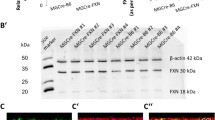Abstract
The Wnt pathway is an essential signaling cascade that regulates survival and differentiation in the retina. We recently demonstrated that retinal ganglion cells (RGCs) have constitutively active Wnt signaling in vivo. However, the role of Wnt in RGC viability or function is unknown. In this study, we investigated whether Wnt protects the retinal ganglion cell line RGC-5 from elevated pressure, oxidative stress, and hypoxia injuries. Expression of RGC marker genes in the RGC-5 cultures was confirmed by immunocytochemistry and PCR. We demonstrated that the Wnt3a ligand significantly reduced pressure-induced caspase activity in RGC-5 cells (n = 5, P = 0.03) and decreased the number of TUNEL-positive cells (n = 5, P = 0.0014). Notably, Wnt3a-dependent protection was reversed by the Wnt signaling inhibitor Dkk1. In contrast, Wnt3a did not protect RGC-5 cells from oxidative stress or hypoxia. Furthermore, Wnt3a significantly increased growth factor expression in the presence of elevated pressure but not in the presence of oxidative stress and hypoxia. These results indicate that Wnt3a induces injury-specific survival pathways in RGC-5 cells, potentially by upregulating neuroprotective growth factors. Therefore, activation of the Wnt pathway by Wnt3a could be investigated further as a tool to develop novel molecular therapeutic strategies for the prevention of RGC death in retinal disease.





Similar content being viewed by others
References
Agar A, Li S, Agarwal N, Coroneo MT, Hill MA (2006) Retinal ganglion cell line apoptosis induced by hydrostatic pressure. Brain Res 1086:191–200
Agarwal N, Agarwal R, Kumar DM, Ondricek A, Clark AF, Wordinger RJ, Pang IH (2007) Comparison of expression profile of neurotrophins and their receptors in primary and transformed rat retinal ganglion cells. Mol Vis 13:1311–1318
Aoun P, Simpkins JW, Agarwal N (2003) Role of PPAR-gamma ligands in neuroprotection against glutamate-induced cytotoxicity in retinal ganglion cells. Investig Ophthalmol Vis Sci 44:2999–3004
Berson DM, Dunn FA, Takao M (2002) Phototransduction by retinal ganglion cells that set the circadian clock. Science 295:1070–1073
Bhattacharya SK, Bhat MB, Takahara H (2006) Modulation of peptidyl arginine deiminase 2 and implication for neurodegeneration. Curr Eye Res 31:1063–1071
Boyd ZS, Kriatchko A, Yang J, Agarwal N, Wax MB, Patil RV (2003) Interleukin-10 receptor signaling through STAT-3 regulates the apoptosis of retinal ganglion cells in response to stress. Investig Ophthalmol Vis Sci 44:5206–5211
Cadigan KM, Liu YI (2006) Wnt signaling: complexity at the surface. J Cell Sci 119:395–402
Cappuccio I, Calderone A, Busceti CL, Biagioni F, Pontarelli F, Bruno V, Storto M, Terstappen GT, Gaviraghi G, Fornai F et al (2005) Induction of Dickkopf-1, a negative modulator of the Wnt pathway, is required for the development of ischemic neuronal death. J Neurosci 25:2647–2657
Chaum E (2003) Retinal neuroprotection by growth factors: a mechanistic perspective. J Cell Biochem 88:57–75
Chen K, Zhang Q, Wang J, Liu F, Mi M, Xu H, Chen F, Zeng K (2009) Taurine protects transformed rat retinal ganglion cells from hypoxia-induced apoptosis by preventing mitochondrial dysfunction. Brain Res 1279:131–138
De Ferrari GV, Chacon MA, Barria MI, Garrido JL, Godoy JA, Olivares G, Reyes AE, Alvarez A, Bronfman M, Inestrosa NC (2003) Activation of Wnt signaling rescues neurodegeneration and behavioral impairments induced by beta-amyloid fibrils. Mol Psychiatry 8:195–208
de Iongh RU, Abud HE, Hime GR (2006) WNT/frizzled signaling in eye development and disease. Front Biosci 11:2442–2464
Fan W, Agarwal N, Cooper NG (2006) The role of CaMKII in BDNF-mediated neuroprotection of retinal ganglion cells (RGC-5). Brain Res 1067:48–57
Fu QL, Li X, Yip HK, Shao Z, Wu W, Mi S, So KF (2009) Combined effect of brain-derived neurotrophic factor and LINGO-1 fusion protein on long-term survival of retinal ganglion cells in chronic glaucoma. Neuroscience 162:375–382
Fuhrmann S (2008) Wnt signaling in eye organogenesis. Organogenesis 4:60–67
Ganapathy PS, Dun Y, Ha Y, Duplantier J, Allen JB, Farooq A, Bozard BR, Smith SB (2010) Sensitivity of staurosporine-induced differentiated RGC-5 cells to homocysteine. Curr Eye Res 35:80–90
Hackam AS, Strom R, Liu D, Qian J, Wang C, Otteson D, Gunatilaka T, Farkas RH, Chowers I, Kageyama M et al (2004) Identification of gene expression changes associated with the progression of retinal degeneration in the rd1 mouse. Invest Ophthalmol Vis Sci 45:2929–2942
Johnson EC, Jia L, Cepurna WO, Doser TA, Morrison JC (2007) Global changes in optic nerve head gene expression after exposure to elevated intraocular pressure in a rat glaucoma model. Invest Ophthalmol Vis Sci 48:3161–3177
Ju WK, Liu Q, Kim KY, Crowston JG, Lindsey JD, Agarwal N, Ellisman MH, Perkins GA, Weinreb RN (2007) Elevated hydrostatic pressure triggers mitochondrial fission and decreases cellular ATP in differentiated RGC-5 cells. Investig Ophthalmol Vis Sci 48:2145–2151
Kaur C, Foulds WS, Ling EA (2008) Hypoxia-ischemia and retinal ganglion cell damage. Clin Ophthalmol 2:879–889
Krishnamoorthy RR, Agarwal P, Prasanna G, Vopat K, Lambert W, Sheedlo HJ, Pang IH, Shade D, Wordinger RJ, Yorio T et al (2001) Characterization of a transformed rat retinal ganglion cell line. Brain Res Mol Brain Res 86:1–12
Kwon HS, Lee HS, Ji Y, Rubin JS, Tomarev SI (2009) Myocilin is a modulator of Wnt signaling. Mol Cell Biol 29:2139–2154
Lambiase A, Aloe L, Centofanti M, Parisi V, Mantelli F, Colafrancesco V, Manni GL, Bucci MG, Bonini S, Levi-Montalcini R (2009) Experimental and clinical evidence of neuroprotection by nerve growth factor eye drops: implications for glaucoma. Proc Natl Acad Sci USA. [E pub ahead of print]
Lin S, Cheng M, Dailey W, Drenser K, Chintala S (2009) Norrin attenuates protease-mediated death of transformed retinal ganglion cells. Mol Vis 15:26–37
Liu H, Thurig S, Mohamed O, Dufort D, Wallace VA (2006) Mapping canonical Wnt signaling in the developing and adult retina. Invest Ophthalmol Vis Sci 47:5088–5097
Logan CY, Nusse R (2004) The Wnt signaling pathway in development and disease. Annu Rev Cell Dev Biol 20:781–810
Martin KR, Quigley HA, Zack DJ, Levkovitch-Verbin H, Kielczewski J, Valenta D, Baumrind L, Pease ME, Klein RL, Hauswirth WW (2003) Gene therapy with brain-derived neurotrophic factor as a protection: retinal ganglion cells in a rat glaucoma model. Invest Ophthalmol Vis Sci 44:4357–4365
Masai I, Yamaguchi M, Tonou-Fujimori N, Komori A, Okamoto H (2005) The hedgehog-PKA pathway regulates two distinct steps of the differentiation of retinal ganglion cells: the cell-cycle exit of retinoblasts and their neuronal maturation. Development 132:1539–1553
McCafferty-Grad J, Bahlis NJ, Krett N, Aguilar TM, Reis I, Lee KP, Boise LH (2003) Arsenic trioxide uses caspase-dependent and caspase-independent death pathways in myeloma cells. Mol Cancer Ther 2:1155–1164
Nadal-Nicolas FM, Jimenez-Lopez M, Sobrado-Calvo P, Nieto-Lopez L, Canovas-Martinez I, Salinas-Navarro M, Vidal-Sanz M, Agudo M (2009) Brn3a as a marker of retinal ganglion cells: qualitative and quantitative time course studies in naive and optic nerve-injured retinas. Invest Ophthalmol Vis Sci 50:3860–3868
Nakamura RE, Hunter DD, Yi H, Brunken WJ, Hackam AS (2007) Identification of two novel activities of the Wnt signaling regulator Dickkopf 3 and characterization of its expression in the mouse retina. BMC Cell Biol 8:52
Nieto PS, Acosta-Rodriguez VA, Valdez DJ, Guido ME (2010) Differential responses of the mammalian retinal ganglion cell line RGC-5 to physiological stimuli and trophic factors. Neurochem Int 57:216–226
Nolan T, Hands RE, Bustin SA (2006) Quantification of mRNA using real-time RT-PCR. Nat Protoc 1:1559–1582
Panagis L, Zhao X, Ge Y, Ren L, Mittag TW, Danias J (2009) Gene expression changes in areas of focal loss of retinal ganglion cells (RGC) in the retina of DBA/2J Mice. Invest Ophthalmol Vis Sci 51(4):2024–2034
Sappington RM, Calkins DJ (2006) Pressure-induced regulation of IL-6 in retinal glial cells: involvement of the ubiquitin/proteasome pathway and NFkappaB. Invest Ophthalmol Vis Sci 47:3860–3869
Seitz R, Hackl S, Seibuchner T, Tamm ER, Ohlmann A (2010) Norrin mediates neuroprotective effects on retinal ganglion cells via activation of the Wnt/beta-catenin signaling pathway and the induction of neuroprotective growth factors in Muller cells. J Neurosci 30:5998–6010
Surgucheva I, Weisman AD, Goldberg JL, Shnyra A, Surguchov A (2008) Gamma-synuclein as a marker of retinal ganglion cells. Mol Vis 14:1540–1548
Tell S, Yi H, Jockovich ME, Murray TG, Hackam AS (2006) The Wnt signaling pathway has tumor suppressor properties in retinoblastoma. Biochem Biophys Res Commun 349:261–269
Tezel G, Wax MB (2004) Hypoxia-inducible factor 1alpha in the glaucomatous retina and optic nerve head. Arch Ophthalmol 122:1348–1356
Tezel GM, Seigel GM, Wax MB (1999) Density-dependent resistance to apoptosis in retinal cells. Curr Eye Res 19:377–388
Umapathy NS, Dun Y, Martin PM, Duplantier JN, Roon P, Prasad P, Smith SB, Ganapathy V (2008) Expression and function of system N glutamine transporters (SN1/SN2 or SNAT3/SNAT5) in retinal ganglion cells. Invest Ophthalmol Vis Sci 49:5151–5160
Van Bergen NJ, Wood JP, Chidlow G, Trounce IA, Casson RJ, Ju WK, Weinreb RN, Crowston JG (2009) Recharacterization of the RGC-5 retinal ganglion cell line. Invest Ophthalmol Vis Sci 50:4267–4272
Van Raay TJ, Vetter ML (2004) Wnt/frizzled signaling during vertebrate retinal development. Dev Neurosci 26:352–358
Vrabec JP, Levin LA (2007) The neurobiology of cell death in glaucoma. Eye (Lond) 21(Suppl 1):S11–S14
Wang WH, McNatt LG, Pang IH, Millar JC, Hellberg PE, Hellberg MH, Steely HT, Rubin JS, Fingert JH, Sheffield VC et al (2008) Increased expression of the WNT antagonist sFRP-1 in glaucoma elevates intraocular pressure. J Clin Investig 118:1056–1064
Wood JP, Chidlow G, Tran T, Crowston JG, Casson RJ (2010) A comparison of differentiation protocols for RGC-5 cells. Invest Ophthalmol Vis Sci 51:3774–3783
Xiang M, Zhou H, Nathans J (1996) Molecular biology of retinal ganglion cells. Proc Natl Acad Sci USA 93:596–601
Yi H, Nakamura RE, Mohamed O, Dufort D, Hackam AS (2007) Characterization of Wnt signaling during photoreceptor degeneration. Invest Ophthalmol Vis Sci 48:5733–5741
Zhou ZJ, McCall MA (2008) Retinal ganglion cells in model organisms: development, function and disease. J Physiol 586:4343–4345
Acknowledgments
The authors would like to thank Drs. Sanjoy Bhattacharya, Livia Bajenaru and Richard Lee for helpful discussions. In addition, the authors thank Dr. Bhattacharya for providing the pressure chamber and Dr. Theodore Lampidis for access to the hypoxia chamber. The authors also extend their gratitude to the donors of ADR, a program of the American Health Assistance Foundation, and Institutional support to BPEI from Research to Prevent Blindness, and an NEI core grant P30.
Author information
Authors and Affiliations
Corresponding author
Rights and permissions
About this article
Cite this article
Fragoso, M.A., Yi, H., Nakamura, R.E.I. et al. The Wnt Signaling Pathway Protects Retinal Ganglion Cell 5 (RGC-5) Cells from Elevated Pressure. Cell Mol Neurobiol 31, 163–173 (2011). https://doi.org/10.1007/s10571-010-9603-z
Received:
Accepted:
Published:
Issue Date:
DOI: https://doi.org/10.1007/s10571-010-9603-z




